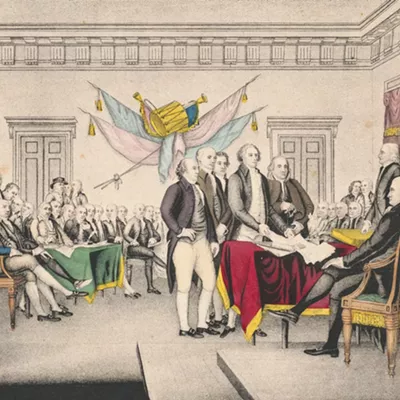The thing that only happens to other people happened to Creta Kunz on a dark November night six years ago. That's when the police knocked on her door and told her that her son Philip was dead. She couldn't believe it. Perhaps there was a mistake? No, there was no mistake. Was it all just a very bad dream? He was at the house just yesterday -- how could he be dead? Suicide, said the officer: He killed himself. Right there, the earth stopped turning. When the planet picked up speed again a few minutes later, Kunz felt more lost than she'd ever felt in her entire life. And she couldn't imagine how she would live through the overwhelming feelings of guilt, sadness, grief and powerlessness.
"For a long time, I, too, wanted to die," says Kunz, about the time following her son's death. "I felt like his life deserved another life in return. And the guilt I felt is like nothing else. I felt like I killed him -- that is the level of guilt I felt. And the grief -- the grief is like insanity. You feel these waves of emotion that you didn't even know you could feel, and you cry so much you didn't even know you could cry so much."
Every year, between 1997 and 2001 in Spokane County, an average of 57 people have taken their own lives. This rate is 24 percent higher than the comparable national rate, making suicide the 10th leading cause of death in this area.
"Suicide and suicide attempts are big problems in all age groups," says A.J. Hutshell, a health educator with the Spokane Regional Health District and the coordinator of the district's Suicide Prevention Coalition. "Especially teenagers are attempting suicide at a higher rate than the rest of the state, and the state rate is higher than the national rate."
Among 15-to-24-year-olds, suicide was the second leading cause of death (18.5 percent) in the time period from 1997 to 2001, topped only by unintentional injuries such as car accidents (44.1 percent).
Suicide attempts by males result in death at almost five times the rate of females, and even though the teen statistics are high, it's males over 65 who are at the highest risk for completing suicide.
Statistics, which are all provided by the Spokane Regional Health District, are based on hospitalizations. Many suicide attempts don't put people in the hospital or even in the emergency room, and therefore are never counted.
No one knows exactly how many suicide attempts have been interrupted at the last minute, but we do know that regardless of age or circumstances, the impact someone's suicide has on friends and family is devastating. Survivors are often riddled with guilt, left to second-guess their own actions or lack thereof.
"He was 29 years old," says Kunz of her son. "He was married, and they had just recently moved back to Spokane from Seattle. He had a hard time finding a job, he wanted to go to school, but they had debt and he didn't have the money to go back to school. I was aware that he was depressed, but we thought it would go away once he got a plan together for his future.
"I don't think we were really aware of how badly depressed he was. I mean, his life situation was such that I didn't find it surprising that he was depressed," says Kunz. "His viewpoint was that he felt like he was about to turn 30 and his life had gone nowhere. If only we had been more aware of some of the signs."
Signs of change -- People who consider committing suicide often change behavior in several ways, but there are no official top 10 signs of suicidal behavior. Especially with teenagers, it can be difficult to get a feel for behavior change because -- as all parents know -- teens often change a certain behavior one day, just to change it back the next.
If your teen usually spends 18 hours sleeping in her room, then that's not necessarily a sign that she is suicidal -- but if she all of a sudden gets by on six hours of sleep, experts say that could be an indicator that something is up. Same goes for eating: If a teen who usually eats a lot stops eating, or someone who's very diet-conscious starts gorging on pizza every night, that can be an indicator as well.
In other words, it's not the behavior itself that indicates suicidal tendencies -- it's the change in behavior one should be aware off.
"One of the things I noticed -- and I now know that this is a sign -- was that he totally went from being depressed and looking like his life was bleak, to being a perky, happy person," says Kunz. "He was changed the last weekend he was here. And we took that change to indicate that things were looking up, that he was looking ahead to the future. And then Monday night he killed himself. I now know that you quite often see that feeling of being at ease, being relaxed, in people who have already made up their mind that they want to kill themselves."
Knowing full well that there are about as many indicators of suicidal tendencies as there are people, the Washington State Youth Suicide Prevention Program offers this list of signs to watch out for, especially with teens:
* A previous suicide attempt -- be aware that sometimes only the person who attempted suicide knows about it.
* Current talk of suicide or making actual plans.
* Strong wish to die or a preoccupation with death.
* Giving away prized possessions.
* Signs of depression such as moodiness, hopelessness and withdrawal.
* Increased use of alcohol or other drugs.
* Hinting at not being around in the future or saying goodbye.
A recent death or suicide in the family, a conflict with parents, a breakup with a boyfriend or a girlfriend or reports in news media about suicides may increase the risk that someone who's considering suicide actually takes his or her plans to completion.
"Another leading indicator is depression," says the Health District's Hutshell. "Everyone gets depressed or goes through a depressed period in their life because something happens -- that's not it. What we are talking about is the clinically depressed person, the person who has bipolar disorder."
And some suicide victims never show any signs at all.
"They don't fit the stereotype of a depressed person. They continue to work, go to school, see their friends, function in any way," says Hutshell. "Yet they struggle with a very deep sense of hopelessness and pain."
Because suicide is surrounded by a lot of taboos, even good friends or family members who have a gut feeling that something isn't right often hesitate to ask directly.
"The best thing you can do is ask the question. Ask them if they are thinking about suicide," says Hutshell. "The worst that can happen is that they get mad at you because they are not suicidal. But ask yourself this: What would you rather have? A dead friend or a mad friend?"
Why? -- It's a myth that one specific event or issue leads a person to committing suicide, and this is especially true for teens. Not only are teens living through a period of life where very fundamental things such as their bodies, their voices and their interests change dramatically, they are also dealing with an increasingly complex social world.
Belonging to the "right" group of friends, owning the "right" sneakers, listening to the "right" music, trying to fit in -- these are all issues that may seem trivial to adults, but can be very difficult to deal with for some teens. And it can be difficult to keep perspective or to continue to have faith in the future, while you are trying to define your own identity.
"Teens don't see an end to what they are struggling with right now. They don't think long-term, that things can get better," says Hutshell. "When you have 15 different problems happening right now, you just don't think about tomorrow."
In 2002, data from the Healthy Youth Survey for Spokane County show that in the past 12 months, 15.8 percent of eighth graders, 18 percent of 10th graders and 13 percent of 12th graders had seriously considered attempting suicide. And more than 63 percent of those who had considered suicide also had a plan ready. Almost 50 percent of eighth graders with a suicide plan had also attempted suicide. It's important to note that these numbers apply only to the students who replied to the survey, and should not be extrapolated to the rest of the population.
Feelings of being overwhelmed or helpless can lead to suicidal thoughts. In the Healthy Youth Survey, 30 percent of 10th graders reported "depressive episodes where they feel so sad or hopeless almost every day for two weeks or more in a row that [they] stopped doing some usual activities."
Again, it's a radical change in behavior that indicates something is wrong.
It's also a mistake to believe that they kill themselves because they want to die.
"Suicide is a very personal thing. And it's very complex, there is never just one thing that makes them do it, not just one reason," says Hutshell. "It's difficult to explain. There may be one thing that happens, and that's what finally makes them want to do it. But suicidal people don't necessarily want to die, they want to end the pain they are in. Many of them have tried ending the pain in ways they know how, and they haven't succeeded. They can't get out of the situation and suicide seems to them to be their last option."
Kunz says she doesn't believe people kill themselves out of vengeance or simply to get back at someone.
"You hear that a lot, but I really don't think that happens very often," she says. "There are so many theories about why people commit suicide, but I think it's about the pain. Whatever pain they feel and why can be hard to say, but they come to believe that they can't get out of it, and that's why they commit suicide."
Ounce of Prevention -- Among mental health professionals, educators and doctors there is widespread agreement that suicide is preventable, yet the suicide rates seem to indicate that what's being done today isn't very successful. Public health programs and initiatives are stretched thin by the usual culprit: lack of funding. But one of the main reasons suicide persists is a lack of openness and willingness to simply talk about the problem.
Lori Hansen started the group Survivors of a Loved One's Suicide (SOS) after her 25-year-old son killed himself in 1988.
"There was no survivors' group back then. I talked to community mental health people and was very fortunate that they had a facilitator who could work with me," says Hansen. "This has worked very well, the combination of me being the peer and her being the professional." The group meets twice a month, with no specific agenda.
"We don't have the answer to the biggest question they ask: Why? There is no blueprint for that," says Hansen. "I'd say about 80 to 85 percent join the group because they think they are crazy, but we can assure them that they are perfectly normal. Losing someone to suicide is a very traumatic loss, followed by traumatic grief."
Over the years, hundreds of people have joined the loosely structured group discussions.
"Survivors talk about how to get through Thanksgiving, birthdays, that sort of thing, what they did," says Hansen.
Kunz was part of the group after her son's death.
"It was a lifesaver, it really was. They just let you talk about what it is that's on your mind. They just listen," she says. "You have to talk about suicide. That's the only way you can get through it. A lot of people are very insensitive or downright stupid about how you feel after losing someone to suicide. I had this college professor who said only cowards commit suicide. I don't think people are intentionally trying to hurt you, it's more like they just open their mouths and this stuff just falls out."
When it comes to preventing suicides and suicide attempts, listening is key as well.
"If you worry about one of your friends being suicidal, ask them. That is the one most important step toward preventing a suicide attempt," says Hutshell. "If you are thinking a person may commit suicide, well, then that person has probably thought about it by him- or herself. And by asking, you show them that you care."
Once a person opens up to you and starts confiding in you, keep comments to a minimum.
"Just listen. Listen, listen, listen, and say you don't want them to die," says Hutshell. "Don't ridicule them or be condescending. Don't say 'Why would you want to do something like that?' That sounds like you are not taking them seriously or that you don't care about how they are feeling. Once you know what's going on, refer them to help. Simply say 'I don't want to be alone with this information.' "
This is the hardest part of intervention, especially for teens who often feel like they are ratting out their friends by "telling."
"With teens, go to an adult. Go to a coach, a parent, a teacher," says Hutshell. "If you really feel like this person is going to do it, stay with them. Call a crisis hotline, get to a counselor, do something like that -- even if they are mad. Let them be mad at you -- that's not as bad as being dead."
Hutshell has worked with some teen support groups that make pacts with one another.
"They'll say, 'I don't want you to hurt yourself until after Christmas' or the football game or whatever it is," she explains. "Then you call them and remind them, you stay in touch, you renew the pact. Slowly, you start building a network around that person."
The Regional Health District's Suicide Prevention Coalition consists of citizens, public and mental health professionals, psychologists and survivors. Its goal is to provide education on suicide and the link to depression, in a way that can be shared at workplaces, schools, physicians' clinics and senior groups, much like how domestic violence programs work.
"We plan activities, like the vigil we have every May, and we try to give people ideas about what they can do to reach out," says Hutshell. "Our overriding educational goal is to let as many people know as possible that suicide is preventable."
In public schools, the statewide Youth Suicide Prevention Program offers classes and training seminars both for students and teachers. It's difficult to gauge the exact impact these prevention programs and initiatives have on death rates -- just as with smoking cessation programs -- but students who participate in the seminars say they become more aware of suicide warning signs and less uncomfortable talking to their friends about suicide.
"The Youth Suicide Prevention Program travels throughout the state, offering tool kits and training at high schools," says Hutshell. "Participants get a binder with lots of information in it, and ideas as to how they can get involved in the prevention work, like how they can create posters or whatever else they would like to do. It all counts."
Though suicide is a personal decision, it has a huge impact not only on those left behind, but on society as a whole.
"Families break up over this. It's devastating," says Kunz. "When it comes to suicide prevention, we need to realize that it's often connected to mental health, to depression. I'm not ashamed of my son. He died from an illness called depression that manifested itself as suicide. You think you don't have to talk about suicide because it only happens to other people. Then one day you realize that you are other people. We have to talk about it."
Getting Help -- For statewide immediate help in preventing suicide in Washington, call: 1-800-SUICIDE
For statewide immediate help in Idaho, call: 1-800-564-2120
The Suicide Prevention Coalition is a good place to start for information on prevention and education programs about suicide. Call: 324-1596
Survivors of a Loved One's Suicide is a support group that meets on the first and third Wednesday of every month, from 7-9 pm at the Red Cross, 315 W. Nora Ave. Call: 487-4711
Reach Out With Hope is a suicide awareness program available to junior and senior high school students and adults. The Spokane Regional Health District and the East Region Emergency Management System sponsor these one-hour presentations. Call: 324-1596
Spokane Mental Health Crisis Intervention Services provides professional triage, crisis respite services, crisis intervention and involuntary treatment services. Call: 838-4428
The Youth Suicide Prevention Program is a statewide program that sponsors school-based initiatives, community education -- including one-hour presentations -- and professional training, as well as an extensive amount of material available in printed or electronic format. Call: (206) 297-5922 or visit www.yspp.org
Sources: The Spokane Regional Health District and the Suicide Prevention Action Network (SPAN) in Idaho
Publication date: 12/04/03














